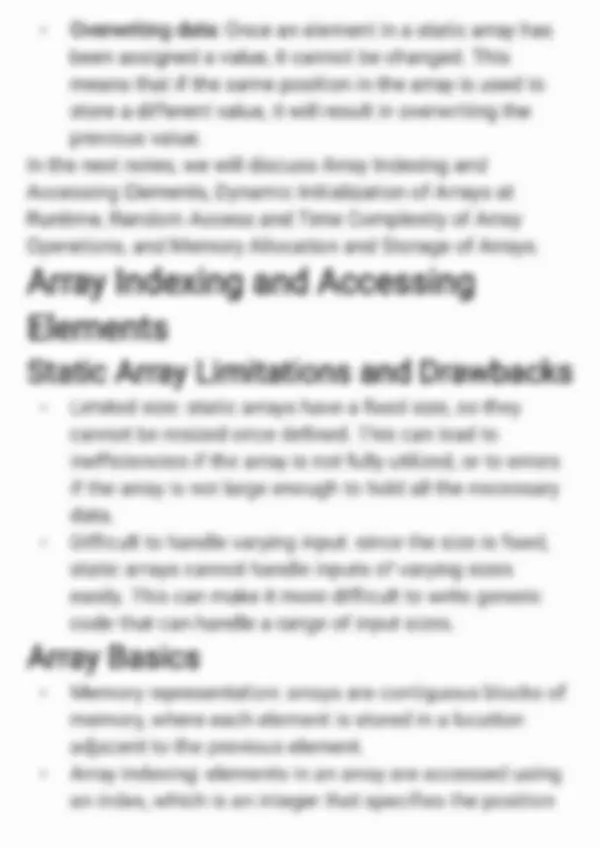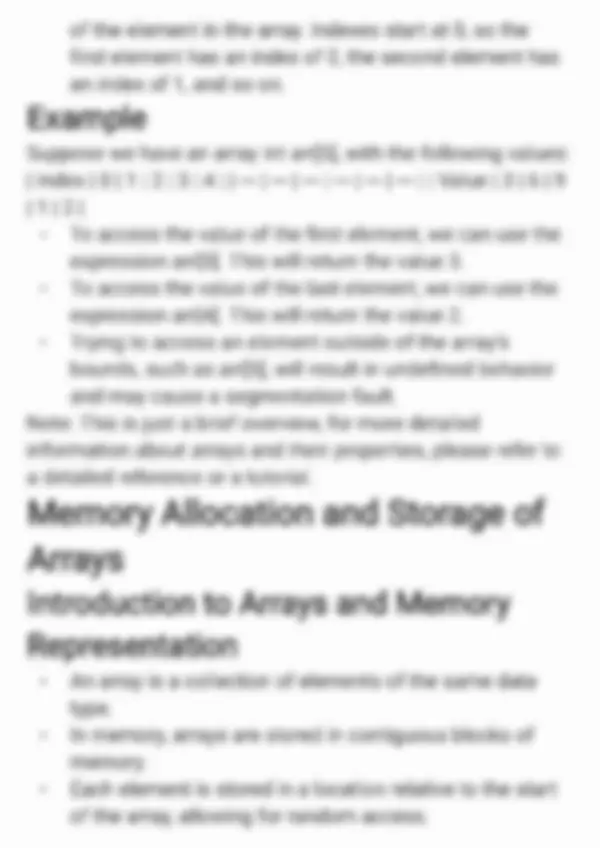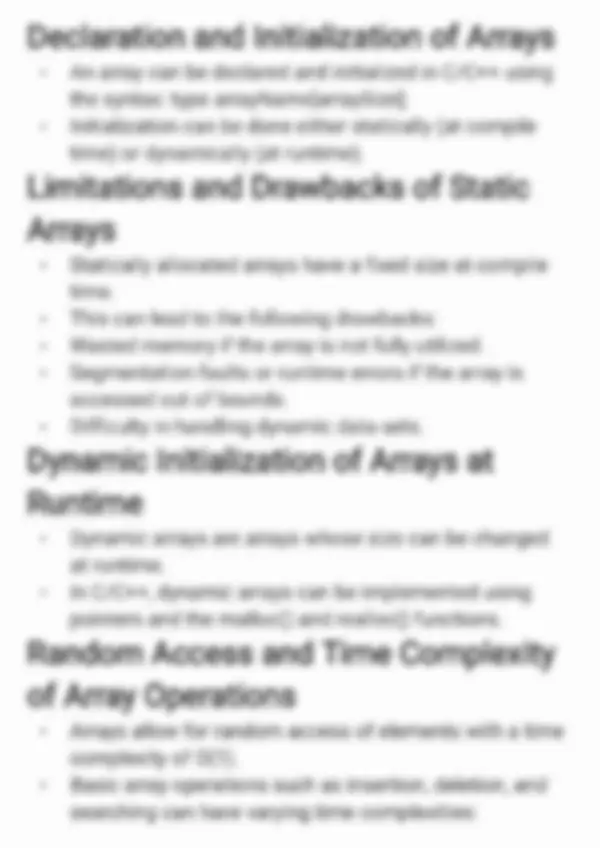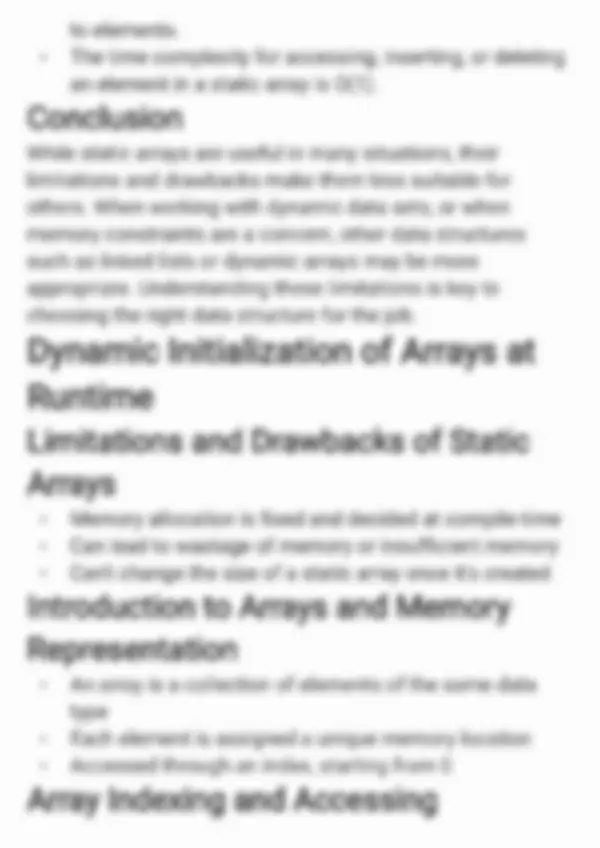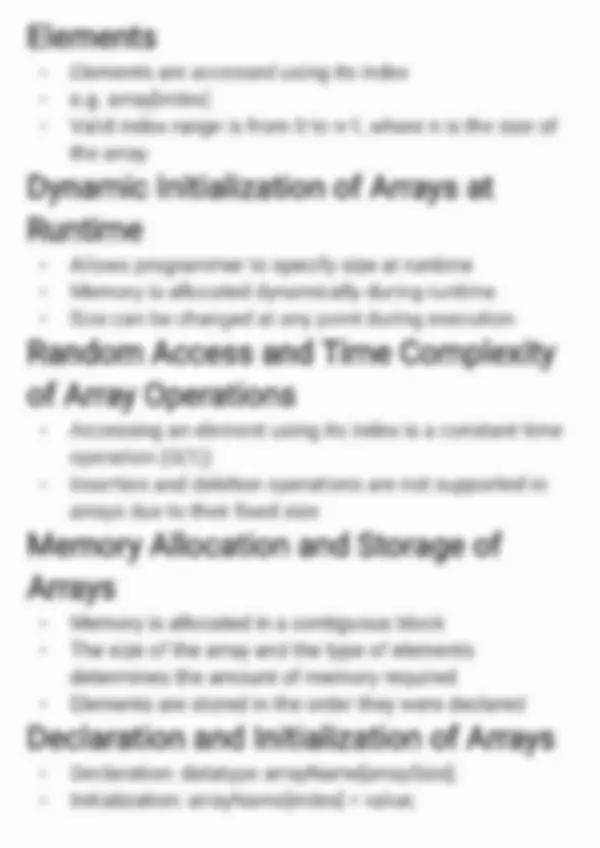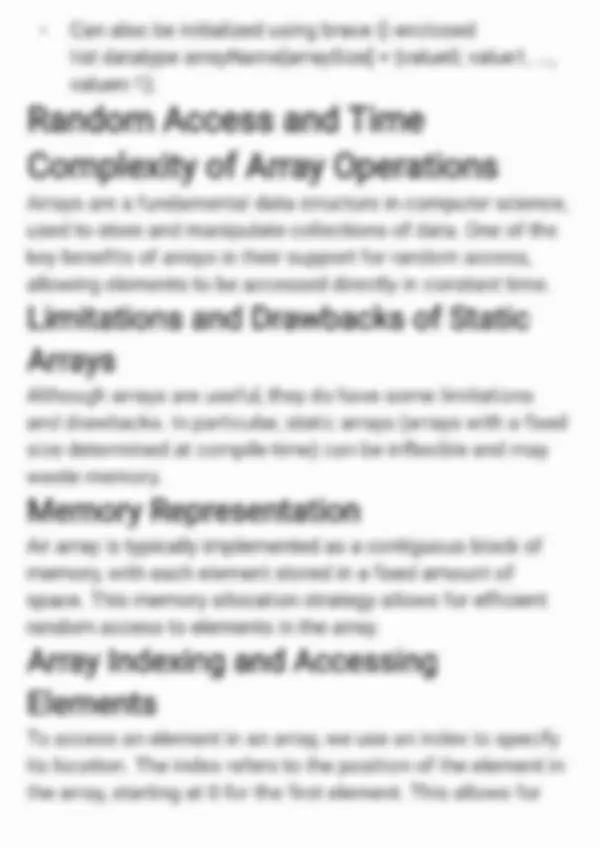Partial preview of the text
Download Data structure summary notes engineering and more Summaries Data Structures and Algorithms in PDF only on Docsity!
Welcome to our discussion on arrays and their memory representation! In this chapter, we will explore how computer memory is organized and how arrays use that organization to store data efficiently. To begin, let's define an array as a collection of elements, all of the same data type, stored in contiguous memory locations. Each element can be individually accessed by its index, which is a unique identifier for its position in the array. The first element has an index of 0, the second element has an index of 1, and so on. Now, let's examine how arrays are stored in memory. Consider the following array of integers: int arr[5] = {1, 2, 3, 4, 5}; This array contains five integers, each taking up 4 bytes of memory. The array is stored in contiguous memory locations, as shown in the diagram below: fot t+ ——F | arr[0] arr[1]| arr[2]| arr[3]| Declaration and Initialization of Arrays Introduction Arrays are a fundamental data structure in computer programming, used to store collections of data of the same type. In this note, we will focus on the declaration and initialization of arrays, as well as their limitations and drawbacks. Declaration and Initialization An array can be declared using the following syntax: dataType arrayNamefarraySize]; where dataType is the type of data that the array will hold, arrayName is the name given to the array, and arraySize is the number of elements the array can hold. For example, to declare an array of integers with a size of 5, the following syntax can be used: int myArray[5]; Initialization can be done using the following syntax: arrayNamelindex] = value; where index is the position in the array where the value will be stored, and value is the data to be stored. For example: myArray[0] = 10; myArray[1] = 20; myArray[2] = 30; myArray[3] = 40; myArray[4] = 50; Limitations and Drawbacks of Static Arrays Fixed size: The size of a static array must be specified at the time of declaration, it cannot be changed later. This means that if the array is not large enough to hold all the data, it will result in an error or the data will be lost. Wastage of memory: If the array is larger than needed, it will result in wasted memory. Initialization required: All elements of a static array must be initialized before they can be used. If this is not done, the array will contain garbage values. of the element in the array. Indexes start at 0, so the first element has an index of 0, the second element has an index of 1, and so on. Example Suppose we have an array int arr[5], with the following values: | Index|0/11213]411-—-|--|--|l--|--|--|] Value]3|/6|9 11] 2| To access the value of the first element, we can use the expression arr[0]. This will return the value 3. To access the value of the last element, we can use the expression arr[4]. This will return the value 2. Trying to access an element outside of the array's bounds, such as arr[5], will result in undefined behavior and may cause a segmentation fault. Note: This is just a brief overview, for more detailed information about arrays and their properties, please refer to a detailed reference or a tutorial. Memory Allocation and Storage of Arrays Introduction to Arrays and Memory RSAC Snel An array is a collection of elements of the same data type. In memory, arrays are stored in contiguous blocks of memory. Each element is stored in a location relative to the start of the array, allowing for random access. Declaration and Initialization of Arrays An array can be declared and initialized in C/C++ using the syntax: type arrayNamelfarraySize]; Initialization can be done either statically (at compile time) or dynamically (at runtime). Limitations and Drawbacks of Static ATS Statically allocated arrays have a fixed size at compile time. This can lead to the following drawbacks: Wasted memory if the array is not fully utilized. Segmentation faults or runtime errors if the array is accessed out of bounds. Difficulty in handling dynamic data sets. Dynamic Initialization of Arrays at Runtime Dynamic arrays are arrays whose size can be changed at runtime. In C/C++, dynamic arrays can be implemented using pointers and the malloc() and realloc() functions. Random Access and Time Complexity ot Array Operations Arrays allow for random access of elements with a time complexity of O(1). Basic array operations such as insertion, deletion, and searching can have varying time complexities: declaration. The size of a static array is set in stone once it's been declared, which can lead to issues if you need to store more data than the array can hold. Declaration and Initialization Static arrays must be declared and initialized with a specific size. This can make it difficult to create arrays of varying sizes dynamically, based on user input or other factors. SEETUTT) Allocation and Storage Static arrays are stored in contiguous blocks of memory. This can lead to issues when trying to store large arrays, as it may not be possible to find a contiguous block of memory large enough to hold the array. Array Indexing and Accessing Elements Static arrays allow for fast and efficient access to individual elements using indexing. However, if an index is out of bounds, it can lead to errors or unexpected behavior. Dynamic Initialization at Runtime Static arrays cannot be dynamically initialized at runtime, meaning their size cannot be changed once they have been created. Random Access and Time Complexity Static arrays allow for fast and efficient random access to elements. The time complexity for accessing, inserting, or deleting an element in a static array is O(1). Conclusion While static arrays are useful in many situations, their limitations and drawbacks make them less suitable for others. When working with dynamic data sets, or when memory constraints are a concern, other data structures such as linked lists or dynamic arrays may be more appropriate. Understanding these limitations is key to choosing the right data structure for the job. Dynamic Initialization of Arrays at Runtime Limitations and Drawbacks of Static Arrays Memory allocation is fixed and decided at compile-time Can lead to wastage of memory or insufficient memory Can't change the size of a static array once it's created Introduction to Arrays and Memory EPICS MEI Ir An array is a collection of elements of the same data type Each element is assigned a unique memory location Accessed through an index, starting from 0 ey, Indexing and Accessing Can also be initialized using brace {} enclosed list datatype arrayName[arraySize] = {value0, value’, ..., valuen-1}; Random Access and Time Complexity of Array Operations Arrays are a fundamental data structure in computer science, used to store and manipulate collections of data. One of the key benefits of arrays is their support for random access, allowing elements to be accessed directly in constant time. Limitations and Drawbacks of Static Arrays Although arrays are useful, they do have some limitations and drawbacks. In particular, static arrays (arrays with a fixed size determined at compile-time) can be inflexible and may waste memory. Memory Representation An array is typically implemented as a contiguous block of memory, with each element stored in a fixed amount of space. This memory allocation strategy allows for efficient random access to elements in the array. Array Indexing and Accessing Elements To access an element in an array, we use an index to specify its location. The index refers to the position of the element in the array, starting at 0 for the first element. This allows for constant time access to any element in the array, since the memory location of an element can be easily calculated based on its index. Dynamic Initialization of Arrays at Runtime In some programming languages, arrays can be dynamically initialized at runtime, allowing the size of the array to be determined at the time the program is running. This can be useful for situations where the size of the data is not known in advance. Memory Allocation and Storage of Arrays When an array is initialized, memory must be allocated to store the elements. The amount of memory required for an array is determined by the size of the elements and the number of elements in the array. It is important to consider the memory requirements of arrays when designing programs and data structures, as using large arrays can lead to excessive memory usage and poor performance. In general, the time complexity of array operations is constant, meaning that they take the same amount of time regardless of the size of the array. This makes arrays an attractive choice for many applications where efficient random access is required. However, it is important to be aware of the limitations and drawbacks of arrays, and to choose the appropriate data structure for the specific problem at hand. In some cases, 
